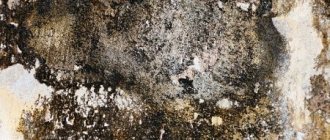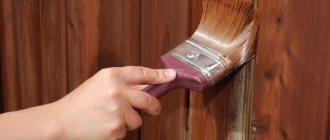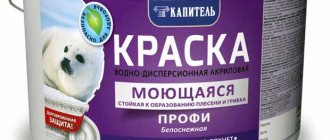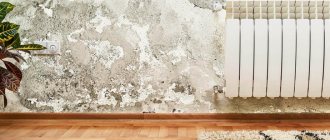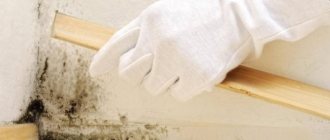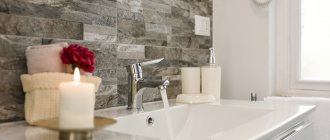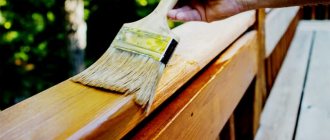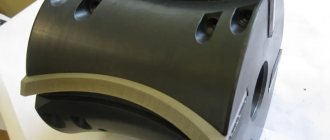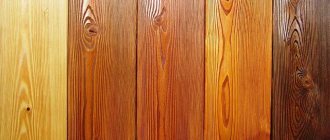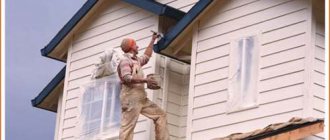If the house was built from wood, then the owners should know that additional protection of the surface from biological formations is required. Any wooden product can be subject to the harmful effects of fungus and mold; they not only destroy the material itself, but also cause health problems in humans. It is important to properly and reliably treat wood against fungus and mold. The best way to do this will be discussed below.
Why does mold or mildew appear?
Before you understand how to treat wood against mold and mildew, it is worth understanding what conditions contribute to their development on the material. The cause is moisture, we are not only talking about the water that gets on the tree and causes rot and biological formations, but also the percentage of humidity in the environment. The most vulnerable premises are basements, subfloors, cellars where potatoes and other products are stored, etc.
By creating a dry microclimate, the material can dry quickly, which helps increase the tree’s resistance to this damage. And the best way is to ensure a constant flow of air; you should take care of ventilation in the house so that the humidity level does not increase.
The cause of mold is moisture.
Question answer
What wood impregnation can be used in the bedroom?
It all depends on what protective properties you want to achieve. For the bedroom, you can use water- or oil-based impregnations. They are completely safe for health. In addition, oil solutions have good decorative properties.
How do you know when it’s time to update your impregnation?
This can be understood by the appearance of the surface: the protective film will begin to crack, peel, and move away from the base. In addition, each can of impregnation indicates its protection period.
How to apply impregnation to the surface?
It all depends on the type of impregnation and its composition. In most cases, solutions can be applied with a regular brush, spray gun or roller. The exception is salt impregnations. The product must be soaked in them.
Can impregnations for outdoor use be used indoors?
In most cases, impregnations for outdoor use have a more aggressive composition and toxicity. The use of such solutions inside residential premises is unacceptable. However, you can choose a universal composition that is suitable for use both inside and outside the home.
What types of wood products can be treated with impregnations?
Impregnations can be used to protect any wooden surfaces: walls, ceilings, railings, furniture, picture frames, etc.
Wood drying methods
As mentioned earlier, the best way to protect the surface is to dry the wood thoroughly, then it will be least susceptible to biological formations. There are 2 types of material drying:
- The natural method is long lasting. It usually takes 12 months to complete the process, but in the end you can get the opposite result, and the wood will not dry, this is influenced by the drying conditions and the preparedness of the material. The wood must be laid on a lattice base to ensure ventilation on all sides. Each row must have transverse panels to ensure that there are no contacting elements of the material. A film covering is laid on top of the stack, thereby creating air access. It is necessary to create favorable conditions in the room - these are positive temperature indicators, preferably +10-15 degrees, there should be no steam emissions in the room, and also the creation of good ventilation. A rapid increase in temperature is not recommended; such a sudden impact can cause cracks to appear and the wood to bend in different directions;
It usually takes 12 months to complete the process. - Forced drying. This technique is characterized by a fast pace of implementation, typically requiring several days to complete. In this case, it is possible to obtain high-quality wood after drying. But only if the forced drying process is carried out correctly. The technique involves exposing the surface to hot steam for periods; this is done to stabilize the humidity on the surface and inside the product, and to prevent the process of cracks from appearing. They also monitor changes in exposure temperature and change indicators according to a certain pattern.
This technique is characterized by a fast pace of implementation, typically requiring several days to complete.
Drying logs without sanding is not permissible; the bark will not allow moisture to escape, and such an influence will lead to the active spread of microorganisms inside.
What are the types of wood preservatives?
Special wood processing products have a classification system. Therefore, when choosing this or that drug, you need to take this into account and carefully read the label.
- Soluble for internal use. They are harmless to humans, odorless, and dry quickly. They are produced in the form of a liquid solution and powder. Used for processing individual boards, wooden walls, windows, railings, parquet, doors.
- Water repellent. They often have a strong, pungent odor. They act many times more deeply than other types. These antiseptics are used to treat baths or saunas.
- Solvent based. When covering wood, a film is formed that takes a long time to dry (12 hours). Used for external and internal work.
- Oil based. Create a protective thick film. It is extremely important that the wood being treated is completely dry, otherwise the fungus will eat it away from the inside.
There are also combined products that combine the characteristics of all the others.
wood antiseptic
Storage, conservation of material
After drying, it is also important to properly store boards, logs, and timber. These products are distinguished by their tendency to absorb moisture; hardwoods are distinguished by this property. To preserve the material, it is placed in a stack on peppered panels, just like when drying, to create good ventilation of the room.
There are also other ways to preserve wooden products:
- Paraffinization, the paraffin is preheated, then the boards are immersed in it to prevent interaction with moisture;
- Applying heated linseed oil; the wood is placed in the oil for a certain period to ensure a penetrating effect and close the pores with the product.
Such woodworking is only possible with well-dried material; if the moisture has not completely left, it contributes to the appearance of wood fungus.
To preserve the material, it is placed in a stack on peppered panels, just like when drying, to create good ventilation of the room.
Top 9 antiseptics for interior work
This list includes both foreign and domestic manufacturers. The main criterion is environmental friendliness and safety.
Pinotex Interior
Pinotex Interior - decorative impregnation for interiors.
Manufactured in Estonia. The water base ensures the absence of a pungent odor. Provides high-quality bioprotection for wood (from rotting, mold, mildew). When applied it does not form smudges. Dries quickly. Absorbs evenly, forming a matte finish. Perfectly hides minor wood defects. Increases surface resistance to dirt and dust. The average price of 2.7 l is 1900 rubles. No deficiencies found.
Tikkurila Supi
Country of origin: Finland. The product is suitable for treating rooms with high humidity (baths, saunas, cellars, showers).
TIRRURILA SUPI SAUNASUOJA
Provides long-lasting antiseptic protection of the material. Forms an acrylate protective layer in a semi-matte shade. The product can be tinted. Impregnation preserves the natural color of wooden structures. Improves resistance to dirt and dust. Used sparingly. Dries quickly. The average price of a 9 liter package is RUB 3,420.
Aquatex Rogneda Extra
Effective impregnation made in Russia with complex action. Provides antibacterial protection against fungus, mold and excess moisture. Prevents darkening from ultraviolet rays.
Aquatex Extra – effective protection up to 7 years
The choice of color palette allows you to create a beautiful imitation of noble tree species.
It is allowed to process both new and old lumber. It's inexpensive. Can be applied with any convenient tool.
Cons: unpleasant odor, long drying time.
The price of a 0.8 l can is 295 rubles.
Neomid 430 Eco
Coating wood with a non-washable antiseptic is reliable protection of raw materials even in extreme climatic conditions. The preservative has good adhesion.
Leave-in antiseptic NEOMID 430 professional
The service life of the protective layer NEOMID 430 ECO is 35 years.
Despite its water base, the product is excellent for treating boards and timber that are in constant contact with the ground and moisture (sauna, greenhouse, cellar). Eco-friendly composition.
The downside is that the material takes on a green color with a gray tint. There is a smell. Sold as a concentrate (1:9). The average cost for 5 kg is 2500 rubles.
Tex Biotex classic station wagon
Country of origin: Russia. Contains a biocide that protects wood from rotting and fungus.
Biotex classic
To improve the effect, the material should be impregnated after preliminary priming.
Use in rooms with high humidity is not recommended.
Can decorate the surface by choosing colors.
But the coating is short-lived (it will have to be renewed after 3-5 years). The smell is unpleasant.
The price is affordable - 2.7 liters for 429 rubles.
Extra Aquatex with wax
Gives products a neat semi-gloss finish. Used for indoor and outdoor work. Protects against fungus and insects. Does not wash out. Suitable for all types of lumber, both old and new.
Aquatex Extra
The composition contains ultraviolet filters that prevent fading due to the penetration of sunlight.
One of the ingredients, wax, well emphasizes the natural structure of the rock and protects against the formation of cracks.
The impregnation is available transparent, in 15 different tints. There are no restrictions in the application method.
Disadvantages:
- fragility of the protective layer (no more than 4 years);
- long drying time.
The price of a liter of impregnation is from 200 to 270 rubles.
Ecohouse
Bioprotection ECOHOUSE
Budget product made in Russia.
Ecohouse does not contain organic solvents, therefore it is environmentally friendly.
The product has an antifungal effect. Effectively fights fungus. After applying impregnation, the material continues to breathe, and the original appearance of the structure is preserved.
Buyers don't like:
- acrid odor;
- long drying time;
- poor coverage.
The price is low, 9 l - 50 rubles.
Belinka Lasur
belinka lasur
Country of origin: Slovenia. Manufacturer: Belinka.
The Lasur antiseptic range contains 17 products in different colors.
Impregnation penetrates deep into the structure of the material without forming a film on the surface and protects against any kind of biological damage.
The composition is used both outside and inside buildings. It is environmentally safe, but during processing it emits a specific odor.
To improve the adhesion and weather resistance of the material, it is recommended to first coat it with Belinka Base.
The price of one liter is 650 rubles.
Veres Classic Lazura
Verus Classic Lazura
Country of origin: Serbia.
It is believed that today Veres Classic Lazura is the best antiseptic for baths and other rooms with high humidity.
Gives wood a silky matte shine. It appears to be a colorless liquid. Excellent resistance to temperature changes. Walls, ceilings, and seats are treated with impregnation. The material retains its natural appearance after application. Has antifungal properties.
The service life of the protective layer is 5–8 years. Does not dilute.
Sold in metal cans, which minimizes the risk of counterfeiting.
The downside is that it takes a long time to dry (up to a day). The price of one liter is 500 rubles.
Vote
Do you know a quality product that should be included on the list? Write about it in the comments!
Users often search for: “Outdoor wood stain.”
Methods for protecting material from damage
To understand how best to get rid of fungus on wood at home, you should study the available methods. There are folk options, as well as special chemicals that are sold in finished form. The methods differ in their operating principles.
There are folk options, as well as special chemicals that are sold in finished form.
Traditional methods
People have long come up with various options for protective impregnation of surfaces; the resulting result, its quality and durability will depend on the type of substance and method chosen.
People have long invented various options for protective impregnation of surfaces.
Smiling
The point is the impregnating effect of the resin; it can be replaced with drying oil. The product closes the pores well, thereby cutting off the possibility of moisture getting inside. Growing trees are protected by nature from the appearance of mold and mildew; it is the natural resin that acts as a barrier; depending on the species, the sap of the tree serves as a barrier.
The product closes the pores well, thereby cutting off the possibility of moisture getting inside.
Burning
If you are going to work with coniferous species, then you can use this method. The surface is burned until the surface darkens. After sanding, it is possible to additionally coat the material with varnish or drying oil to enhance the effect. Firing promotes baking of the resin, which ultimately blocks the access to moisture.
Firing promotes baking of the resin, which ultimately blocks the access to moisture.
Surface coating with hot bitumen
Bitumen agents can help get rid of fungal attack; the process itself is identical to the waterproofing method when working with walls and foundations. Due to the danger and complexity of the treatment, this technique is unpopular. Bituminous substances can only be used on the outside of structures.
Bitumen products can help get rid of fungal exposure.
A mixture of vegetable oil and propolis
A similar anti-mold for wood is prepared in an oil to propolis ratio of 3:1. The tool to apply the composition is a brush. As a result, you get a matte, stable layer that is transparent; therefore, it will not be able to cover black or blue stains from fungus. It should be noted that the product increases the fire hazard properties of the material.
The product increases the fire hazard properties of the material.
Application of silicate glue
Silicate-based glue is diluted with water to create a paint-like consistency. The treatment is carried out with a brush or roller; a two-layer coating is required. The result will not protect the surface for a long time, nor will it help against all types of fungus.
Silicate-based glue is diluted with water to create a paint-like consistency.
Soda and vinegar
These affordable means help get rid of existing mold formations and cure the material. First, the surface is covered with soda, then 9 percent vinegar is sprinkled onto it. Because of the resulting reaction, harmful fungi die, and those that were deep in the structure of the tree are also affected. Such exposure is usually enough to ensure that you never see mold on these products again. If the question is asked, how to get rid of fungus in the underground of a wooden house, then the remedy is suitable.
These affordable means help get rid of existing mold formations and cure the material.
Slaked lime
An effective and simple product that can be found on sale ready-made, or you can prepare the product yourself.
An effective and simple product that can be found on sale in a ready-made version.
Treating wood with copper sulfate solution
Copper sulfate is diluted with water, the ratio will be created at the rate of 100 grams of copper sulfate per 10 liters of water. The product is reliable and copes with the task if applied in two layers. But the surface will have a greenish-blue tint; therefore, most often the wooden base is painted afterward.
The product is reliable and copes with the task if applied in two layers.
A mixture of clay and salt
Take clay/water/salt and mix it together in a ratio of 75/20/5. The solution is effective, but is applicable for interior work, or if the facing material will be installed in the future. The product forms a crust that prevents the colonization of wood by insects, etc.
The product forms a crust that prevents insects from colonizing the wood.
Boric acid
To prepare the substance, you need 50 grams of boric acid, a kilogram of salt and hot water. You can apply the prepared solution with a brush or spray.
These recipes are the only possible option when it is necessary to treat the surfaces of baths and saunas, where the use of chemicals is dangerous. It is impossible to use only the tarring method in these structures.
You can apply the prepared solution with a brush or spray.
Causes and conditions for the appearance of fungus
The tree of almost all deciduous and coniferous species is, to a greater or lesser extent, food and a favorable habitat for various wood and other mold fungi. This especially applies to sawed and fallen trees, since when the plant dies, its natural immune processes cease. You can often see spots of gray-blue or black color on the end of the logs and the planed surface of the boards: these are traces of damage and such lumber is less suitable for use in construction on load-bearing and other critical areas. In addition, they must be treated in several stages with special antiseptic antifungal drugs - fungicides.
Since spores (a kind of seeds) of fungi spread by air, they can land anywhere, but they grow and reproduce only under certain conditions:
- dampness;
- standing air;
- significant temperature fluctuations;
- no or limited natural light;
- poor or no waterproofing of the building at high groundwater levels or in a damp climate;
- freezing;
- dirt.
The spongy, porous structure of the bark, if not removed from the log quickly after cutting and clearing of branches during the logging process, is also considered an “invitation” for fungal spores, especially when the log lies damp on the ground. That is why the quality of lumber is already formed at the harvesting stage.
The planed surface of beams and boards after sawing even a clean log is another “door” for parasites. Organizing ventilation of stacked stacks for natural (not extreme) drying and protection from mold is the most important condition for storing lumber: dense stacking is cheap and saves space, but for the buyer this attitude should serve as a reason for a careful inspection of each board purchased.
Read also How and with what can you dilute alkyd paint
How to choose the right tool and method
When choosing, take into account how long the coating lasts in order to know when it will be necessary to renew the protective layer. To calculate how much product to purchase, you should know the consumption of the product and the number of layers that are needed for the product to be effective. Pay attention to the purpose - treatment indoors or outdoors.
There are products with a hypoallergenic composition; if this indicator is important, then you need to look for such instructions from the manufacturer.
When choosing, take into account how long the coating lasts in order to know when it will be necessary to renew the protective layer.
Prevention methods
The main option to prevent the appearance of fungal infections on a wooden surface is to create regular ventilation at any time of the year, no matter whether it is winter or spring. Antifungal substances must be applied to the outside of the house; do not forget to update them periodically. If defects appear on the material, they are also processed.
The main option to prevent the appearance of fungal infections on a wooden surface is to create regular ventilation at any time of the year.
It is necessary to apply antiseptic solutions to a wooden base, then there will be no harm to human health, and the material itself will last longer. Don't forget about preventative measures. The choice of means is made based on the operating conditions and the extent of the problem.
Let's sum it up
The defeat of wooden structures by any type of mold is a serious challenge that must be accepted and fought against this evil.
Today you have at your disposal a whole range of folk remedies and special antiseptic preparations produced by the chemical industry. It must be admitted that industrial antiseptics still benefit in efficiency and duration of action and fully justify their cost.
If your attic, shed, or any other area where woodwork or trim is present does not reveal any signs of mold on close inspection, consider applying a protective antifungal treatment in some suitable manner and ensure healthy conditions - good ventilation, normal humidity, absence of significant temperature changes in rooms, waterproofing of lower wooden structures. This will create big problems for mold, and in combination with protective treatment will reduce the likelihood of infection to a minimum and maintain a healthy environment in the premises.
